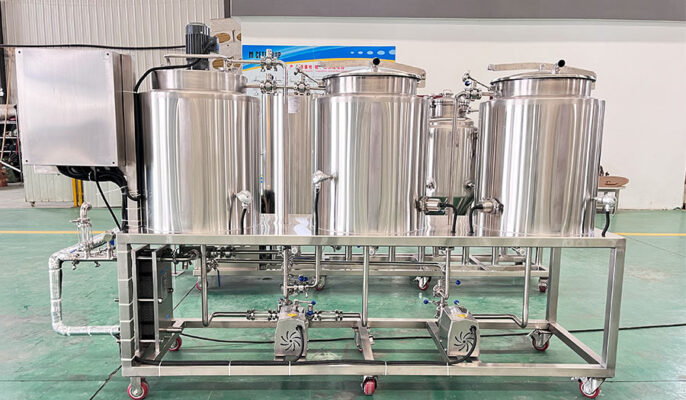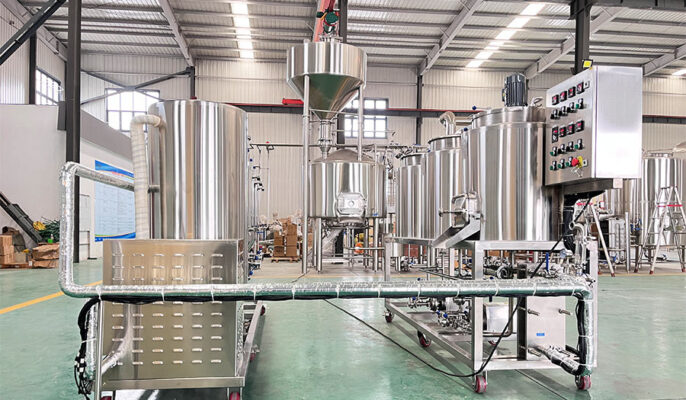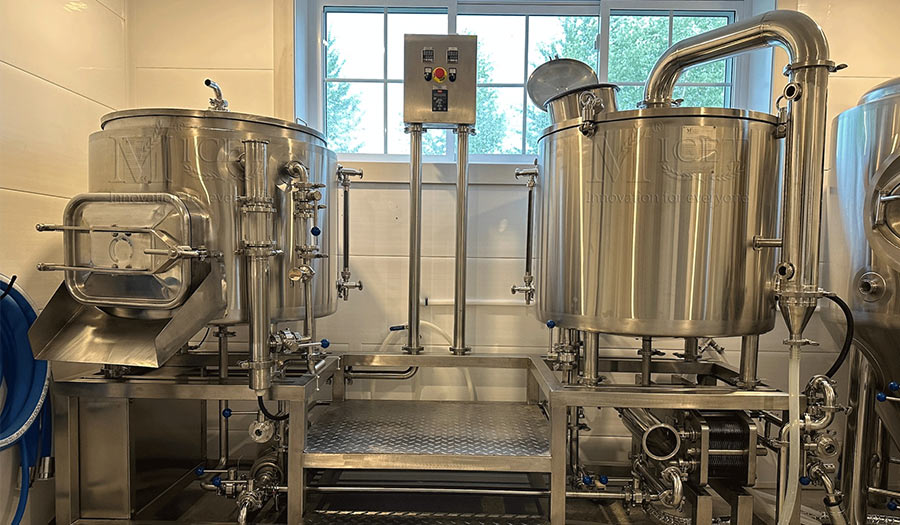In recent years, the rapid rise of craft beer culture has attracted the attention of many brewers. Starting a minibrewery, as a flexible and personalized way of brewing, not only satisfies consumers’ pursuit of unique flavors but also provides entrepreneurs with a platform to showcase their creativity. Both enthusiasts and professionals can find their position in this field. Starting a minibrewery is not an easy task. It involves market analysis, equipment procurement, production process, financial budget, and marketing strategy. In this ultimate guide, we will conduct an in-depth analysis and hope to provide you with comprehensive support.
Was ist eine Minibrauerei?
A mini brewery, often referred to as a microbrewery or craft brewery, is a small-scale beer production facility that focuses on brewing beer with unique flavors and high quality. Mini beer brewing systems are essentially scaled-down versions of professional breweries. These systems are designed for personal use, allowing amateurs and craft beer enthusiasts to brew their beer at home. They come in a variety of sizes, but are usually compact and can be placed on a kitchen counter or in a small storage space. Unlike large commercial breweries, mini-breweries usually emphasize hand-brewing and small-batch production, pursuing innovation and personalized styles.

Features of mini-breweries:
- Small scale: The production scale is relatively small, and the amount brewed each time is usually limited, making production flexible and able to respond quickly to market changes.
- Focus on quality: Mini breweries usually use high-quality raw materials and pay attention to every detail in the brewing process to ensure the flavor and quality of the beer.
- Innovation and diversification: These manufacturers often try different recipes, flavors, and styles, and launch limited edition or seasonal beers to meet consumers’ pursuit of freshness.
- Localization: Many mini-breweries tend to cooperate with local farms, use local raw materials, and strengthen ties with the community.
Mini Brewery Market Analysis
Market Demand
As consumers’ requirements for beer quality and taste increase, mini-breweries have gained more and more attention in the market. Especially among young people, the popularity of craft beer has increased year by year. According to market research, the consumption growth rate of craft beer is much higher than that of traditional beer.
Competition Analysis
Before deciding to start a mini brewery, it is necessary to conduct a detailed investigation of local competitors. Analyzing competitors’ product types, prices, market share, and customer groups can help entrepreneurs find their market positioning. Understanding the strengths and weaknesses of competitors will help formulate corresponding business strategies.
Zielmarkt
Identifying the target market is the key to success. Mini breweries can sell products through multiple channels such as bars, restaurants, and supermarkets, and can also promote and sell them through online platforms. According to different target consumer groups, formulate corresponding marketing strategies.
Ausrüstung für die Brauerei needed for mini-breweries
Brew pot
The brew pot is a vital piece of equipment in the beer production process, used to boil malt and add hops to extract flavor and aroma. There are many types of brewpots, mainly divided into two types: electric heating and steam heating. Electric heating brewpots are easy to operate and heat quickly, suitable for small-scale production; while steam heating brewpots have better temperature control capabilities, are suitable for large-scale production, and can heat the wort more evenly to avoid coking.
Gärbehälter
The fermentation tank is the core link in beer production and is specially used for the fermentation process of yeast. Generally, high-quality stainless steel is used, which is popular for its excellent corrosion resistance and easy cleaning. The design of the fermentation tank usually includes a temperature control system that can accurately adjust the fermentation temperature to ensure that the activity of the yeast and the flavor of the beer is in the best state.
Das Kühlsystem
The main function of the cooling system is to quickly reduce the temperature of the boiled wort to ensure the activity of the yeast during fermentation. Commonly used cooling equipment includes plate coolers and spiral coolers, which can effectively cool down in a short time, reduce the risk of microbial contamination, and maintain the fresh taste of beer.
Ausrüstung für die Filtration
Filtration equipment is used to remove yeast and impurities produced during the fermentation process, making the beer clearer and more transparent. Common filtration methods include mechanical filtration and membrane filtration. Different filtration technologies can be selected according to the type of beer and flavor requirements to ensure the quality and visual effect of the finished beer.
Bottling/Canning equipment
Bottling and canning equipment are used to package finished beer for easy sales and transportation. These equipment usually have automation functions, which can improve packaging efficiency and reduce labor costs. Reasonable packaging can not only extend the shelf life of beer but also attract consumers’ attention through exquisite design.
Brauprozess
- Mashing: Mashing is the process of soaking the crushed grains in hot water to activate enzymes, which convert starches into fermentable sugars. The mash is kept within a specific temperature range (usually 150°F to 160°F) for about an hour to fully dissolve the sugars.
- Sieden: Nach dem Einmaischen wird die entstandene Flüssigkeit (Würze genannt) gekocht. Dieser Schritt ist wichtig, um die Mischung zu sterilisieren und Hopfen hinzuzufügen, der dem Bier Bitterkeit, Geschmack und Aroma verleiht. Je nach Rezept kann der Hopfen zu verschiedenen Zeitpunkten des Kochvorgangs zugegeben werden, um unterschiedliche Geschmacksrichtungen zu erzielen.
- Cooling: After the wort is boiled, it needs to be quickly cooled to a temperature suitable for yeast fermentation (usually around 70°F). This is where a wort chiller comes in handy. The rapid cooling process helps prevent contamination from wild bacteria and yeast.
- Gärung: Die gekühlte Würze wird in einen Gärtank umgefüllt und mit Hefe versetzt. Die Gärung ist die Phase, in der die Hefe den Zucker aufnimmt und in Alkohol und Kohlendioxid umwandelt. Die Gärung kann je nach Bierstil zwischen einer Woche und mehreren Monaten dauern.
- Bottling/kegging: Once fermentation is complete, the beer is either bottled or kegged. Some brewers may also choose to carbonate the beer at this stage by adding a small amount of sugar before sealing it in the bottle, or by using CO2 to keg it.

Mini beer brewing system capacity and space selection
|
Faktor |
SMALL BREWING SYSTEMS (1-3 GALLONS) |
MEDIUM BREWING SYSTEMS (5-10 GALLONS) |
LARGE HOME SYSTEMS (10+ GALLONS) |
|
Kapazität |
Ideal for beginners or those with limited space. Brews small batches for personal use. |
Suitable for brewing larger batches for events or regular consumption. |
Produces large quantities of beer, often comparable to small craft breweries. |
|
Platzbedarf |
Can fit on a kitchen counter or in small spaces. |
Requires a dedicated brewing space, like a garage or basement. |
May need significant space, similar to a home bar or a small brewery setup. |
|
Personalisierung |
Limited customization options but perfect for beginners. |
Moderate customization options for adjusting recipes and techniques. |
Highly customizable, with options for advanced brewing techniques. |
Finanzieller Haushalt
- Start-up capital: Start-up capital includes equipment purchase costs, raw material purchase costs, rent, decoration costs, and other operating costs. Depending on the scale and market positioning, the demand for start-up capital will vary.
- Operational costs: Operating costs mainly include labor costs, water and electricity costs, raw material costs, and marketing costs. The fluctuation of each cost should be taken into account when budgeting to ensure the safety of the capital chain.
- Profit forecast: Based on the determination of the selling price, combined with market demand and sales channels, a profit forecast is made. This can help entrepreneurs understand the return on investment more clearly.
Schlussfolgerung
Starting a mini brewery is a challenging and creative business. Through comprehensive market analysis, reasonable site selection, scientific production process, effective marketing strategy, and rigorous financial management, you can find your own foothold in this highly competitive market. If you want to know more about beer brewing equipment, you can contact Micet Group, our professional engineers will give you more customized requirements for brewing equipment.




